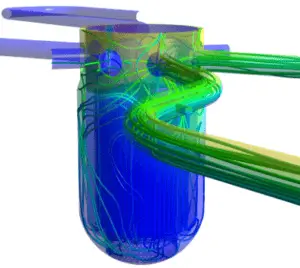Solution of Navier-Stokes Equations

Source: CFD development group – hzdr.de
Even though the Navier-Stokes equations have only a limited number of known analytical solutions, they are amenable to fine-gridded computer modeling. The main tool available for their analysis is CFD analysis. CFD is a branch of fluid mechanics that uses numerical analysis and algorithms to solve and analyze problems that involve turbulent fluid flows. It is widely accepted that the Navier–Stokes equations (or simplified Reynolds-averaged Navier–Stokes equations) are capable of exhibiting turbulent solutions, and these equations are the basis for essentially all CFD codes. It is possible now to achieve approximate, but realistic, CFD results for a wide variety of complex two- and three-dimensional viscous flows.
The Navier–Stokes equations are also of great interest in a purely mathematical sense. Unfortunately, the highly intermittent and irregular character of turbulent flow complicates all analyses. It has not yet been proven that in three dimensions solutions always exist, or that if they do exist, then they are smooth. In fact, general solution of the Navier-Stokes equations with turbulences is often said to be the “last unsolved problem in classical mathemetical physics.”
We hope, this article, Solution of Navier-Stokes Equation, helps you. If so, give us a like in the sidebar. Main purpose of this website is to help the public to learn some interesting and important information about thermal engineering.